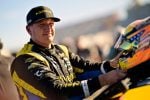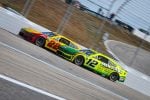The 1992 NASCAR Cup Series season has become a part of racing history largely because of Alan Kulwicki’s dramatic and strategically masterful performance at Atlanta Motor Speedway (now EchoPark Speedway) that earned him the championship by a mere 10 points over Bill Elliott.
The Hooters 500 on Nov. 15, 1992, is considered by many to be NASCAR’s greatest race for more reasons than its riveting finish. For example, Rick Houston authored the book NASCAR’s Greatest Race: The 1992 Hooters 500.
Three drivers entered the race with realistic chances at the title – Elliott, Kulwicki and Davey Allison. They were separated by only 40 points, which meant that they had to race. “Stroking “and other conservative strategies were useless.
The event was the last for NASCAR icon Richard Petty, who had been competing for 35 years and earned 200 victories. At Atlanta, he made the 1,184th start of his storied career. He received almost as much attention as the intense championship battle.
Additionally, although not as widely recognized, the race was the first Cup start for an upstart youngster named Jeff Gordon, signed as the latest protege for Hendrick Motorsports.
As much as the final race at Atlanta has characterized the 1992 season, there was a time, early in the campaign, when it appeared all would end decidedly mundane.
One driver dominated, so much so that it was speculated he would claim the title easily. Maybe he would acquire enough points to only have to start his car at Atlanta to become the champion. Or, perhaps, he would only need to make a casual Sunday drive to do so.
Of course, neither possibility became fact. But after only five races into 1992, it seemed Elliott might have enough to make it so.
Elliott was in his first season with team owner Junior Johnson, whose Ingles’ Hollow, N.C., operation had grown to two teams with driver Sterling Marlin.
A bit of irony: In 1991, Johnson offered his ride to Kulwicki, who refused because he was convinced he had acquired a major sponsor in Maxwell House Coffee.
“I told him time and again he didn’t have that sponsor,” Johnson said. “I knew that because I had it (for Marlin).”
Many observers felt the Elliott-Johnson combination would be very hard to beat. Johnson was one of the most innovative and successful owners in NASCAR, with six championships and 124 victories in 24 seasons.
Ellott was a long-established superstar who had turned racing on its ear in 1985 with 11 superspeedway victories and a championship in 1988. He had earned 35 career wins prior to his association with Johnson.
“I tried to hire Bill six or seven years ago,” said Johnson, who won his last championship in 1985. “I believed then and I believe now we can win a championship. But the circumstances just weren’t right. It took a long time, but this time they were. Bill has the style to win championships. He’s got the finesse it takes.”
Things got off to a solid start at the Daytona 500 when Johnson’s Fords swept the top two qualifying positions with Marlin on the pole.
But at the halfway point of the race, Elliott and Marlin were swept up in an accident with Ernie Irvan. Elliott recovered, but had to settle for 27th place.
Then came the month of March. Elliott was unbeatable. He won four consecutive races – at Rockingham Speedway, Richmond Raceway, Atlanta and Darlington Raceway – to become, at that time, only the fourth driver in NASCAR’s Modern Era (post 1971) to do so.
The others were Cale Yarborough in 1976, Darrell Waltrip in 1981, Dale Earnhardt in 1987 and Harry Gant in 1991. Ironically, both Yarborough and Waltrip drove for Johnson when they accomplished the feat. And both won championships.
“We’ve been good and we’ve been lucky in these last four races,” said Elliott at Darlington. “Today, the car was OK. It performed well enough that I was able to save it and the tires for the finish. In all these races, you pretty much have to race the track until it’s time to make a move. Patience is the key.”
Now, no one would have been surprised if Elliott had a firm grip on the points lead after he won four of the season’s first five races.
So, it was almost too difficult to believe that he was not the points leader. After Darlington, he was 48 points behind Allison, winner of the Daytona 500.
For many, it was hard to fathom. It would seem to be even harder to do so today, when a victory assures a driver a spot in the playoffs.
At the time, the points system was designed to reward consistency over victory. Even with four wins, Elliott was unable to recover sufficiently from his 27th-place showing at Daytona International Speedway.
Allison, meanwhile, followed up his Daytona 500 victory with finishes no less than fourth in the next four events – a model of consistency.
Over the course of the season, it evolved that Elliott would occupy first place in points at times and remain in close contention with Allison and Kulwicki as the schedule advanced to the fateful season’s end at Atlanta.
Going into that race, Allison led Kulwicki by 30 points, with Elliott 40 points in arrears.
Something else happened as the ’92 season progressed. After Darlington, Elliott went winless until the final event. As dominant as he had been, while he did enjoy several good finishes, victories dried up.
It didn’t take long for rumors, speculation and conspiracy theories to blossom. The word spread – Elliott’s hot streak was accomplished by cheating.
Johnson had been up to some trickery, it was said. Whatever he was up to had been working perfectly until NASCAR found out – or perhaps, was quietly informed of it. And, it was speculated, the sanctioning body, rather than make a public issue of it all, informed Johnson to cease and desist. That made all the difference.
It was all the same a year earlier, when Gant went on his four-win spree in September. It was rumored that NASCAR demanded that his Leo Jackson team cease the chicanery. Gant won only three times in his final three years of competition.
Frankly, I have little doubt Johnson found an edge. It likely wasn’t entirely legal, which was probably enough for NASCAR to say cease and desist rather than publicly implement punishment.
And add that Tim Brewer was Elliott’s crew chief. Brewer is a self-admitted master of skullduggery. In fact, I am certain he’s proud of it.
After his March romp, Elliott didn’t win again until Atlanta. And even that was not enough to claim the title he and Johnson coveted, because Kulwicki finished second and led the most laps.
I do know that in the years since ’92, Johnson has never forgotten the Atlanta race and how things might have turned out differently had circumstances gone his way. I daresay it’s the same for Elliott.
Steve Waid has been in journalism since 1972, when he began his newspaper career at the Martinsville (Va.) Bulletin. He has spent over 40 years in motorsports journalism, first with the Roanoke Times-World News and later as publisher and vice president for NASCAR Scene and NASCAR Illustrated.
Steve has won numerous state sports writing awards and several more from the National Motorsports Press Association for his motorsports coverage, feature and column writing. For several years, Steve was a regular on “NASCAR This Morning” on FOX Sports Net and he is the co-author, with Tom Higgins, of the biography “Junior Johnson: Brave In Life.”
In January 2014, Steve was inducted into the NMPA Hall of Fame. And in 2019 he was presented the Squier-Hall Award by the NASCAR Hall of Fame for lifetime excellence in motorsports journalism. In addition to writing for Frontstretch, Steve is also the co-host of The Scene Vault Podcast.





